Potstickers, or gyoza, or fried Chinese dumplings — I love them no matter what you call them. Ethan taught me to make them when he was home for Christmas from Japan (quite a long time ago now!) They’re a bit fussy, but great food for a party in the kitchen – everybody folds dumplings for half an hour or so (make sure they wash their hands!), and then the feast begins.
Not too long ago, potstickers started turning up in bags in the frozen section in my local grocery. They have become a staple for working people, who arrive home STARVING and need to eat in a hurry. I thought my prayers had been answered – potstickers in small quantities on demand! Now, maybe I’m just getting picky in my old age, but the filling in the commercial products makes me a little cranky. They seem to rely on a whole lot of cabbage to extend the meat, and I’m not sure exactly what the binder was in the recent shrimp batch I picked up. Also, they’re a little bland. I would prefer the dumpling itself to have lots of flavor, instead of relying on the dipping sauce for zip.
Enough complaining! I choose to make my own, both dumplings and sauce, because I can.
This posting is a “How To” rather than a recipe. It’s just a guideline – I really hope you’ll make all kinds of creative decisions if you try it yourself! Gyoza wrappers are available from Oriental grocery stores, but regular small wonton skins, available in most major grocery stores, will work just fine.
Potstickers, Gyoza, or Chinese Fried Dumplings
Ingredients:
Some people might want to go all-in and make their own wrappers. That’s too much for me. If you really want to go that route, instructions are readily available online (click here).
My “recipe” makes enough filling for about 45 dumplings, which is approximately how many wrappers there are in a single package. You can make fewer, but they freeze really well , so throw caution to the wind and make a whole batch!
- 8 ounces (225 grams) of protein – shrimp, scallops, salmon, pork, chicken, turkey, even beef – raw and ground or finely chopped
- 1 cup of cabbage, finely chopped (you can use less, but use at least some – it breaks up the meat for a more tender filling)
- 2 Tbsp finely chopped water chestnut or jicama for crunch (see below)
- 2 Tbsp (or more) finely chopped green onion, or regular onion, or shallot, or even chives
- 1 tsp (or more) finely ground or chopped fresh ginger, which figures in almost all recipes researched. ½ tsp dry ground ginger will work in a pinch (tee hee – pun – “a pinch of ginger”…. Never mind.)
- Garlic is optional, but very nice in a meat filling, and part of the ‘traditional’ flavor profile
- 1 egg white – Optional
- Flavoring: While soy sauce and sesame oil always appear, there are no limits — feel free to be creative.


Method:
Making the filling is the creative part of this activity, but should perhaps be a solitary one. If you are planning a gyoza-folding party, make the filling ahead and refrigerate it well. It’s just food-safer that way.
Whatever protein you choose needs to be quite finely chopped or ground — easy to buy that way for pork, chicken or beef. With the shrimp and scallops I had, I pureed some in the food processor so it would act as “food glue” and hold everything together, and hand-chopped some for texture.


Regardless of your chosen flavor, pork is often part of the filling mixture in researched recipes, adding both flavor and fat. Fat makes the filling tasty, tender and juicy. I have seen recipes that add finely-diced meat-flavored gelatin for juiciness, but I think that wanders into “soup dumpling” territory, which is somewhat specialized and not what I was shooting for. Since my seafood mixture was very lean, I added a teaspoon or so of vegetable oil.
I have learned from Cook’s Illustrated that the addition of just a tiny bit of baking soda to any ground protein will alter the pH, and prevent the fibres from bonding too tightly, resulting in a more tender meatball, spaghetti sauce or shepherd’s pie filling. The ratio is about 1/4 tsp per 16 ounces of ground meat, so perhaps 1/8 teaspoon, sprinkled over your choice of protein (tossing to distribute) might have a positive effect. It can’t do any harm.
If you don’t add any vegetables to your filling, you may end up with a hard little meatball wrapped in noodle. Whatever you add, it needs to be finely chopped. Cabbage is the most common go-to, but the sky’s the limit (Broccoli stems? Asparagus?). I used bagged cole-slaw mix, and took the time to salt it to draw out some of the moisture and give it a slightly pickled flavor. If I was using a really wet vegetable, like mushrooms or asparagus, I would take the time to pre-cook them before adding them to the filling, to concentrate their flavor and reduce their water load.


Something crunchy adds a good textural element to the filling. Water chestnuts are often chosen, but it’s a bit hard to come up with ways to use the rest of the can. Meet Mr. Jicama. This winter vegetable has a crispy texture, and a pleasant sweet taste something like a cross between a potato and a cucumber. It’s great raw for snacking, and you can use it in any stir fry.


Onion is a must, in some form. Green onions add a nice, bright flavor, and lovely color. Chives are classy and more subtle. Any kind of onion will do. Leeks, shallots, and green onions need only fine dicing. If I was using regular old onion, I would probably chop it finely and sweat it off in a bit of oil before adding it to the mix, but that’s because I have an aversion to both the texture and harsh flavor of raw onion, particularly red onion. Suit yourself.


Ginger gives the dumplings the flavor you’d be missing if you left it out. Debbie gave me this grating dish a while ago. While I think it was designed for garlic, I have found it to be the BEST ginger grater there is – even better than my microplane. It gives you nice juicy pulp, but leaves the stringy fibers behind.
Add just a hint of ginger, or add a lot, depending on what flavor you want to achieve. I would add lots to chicken, but only added a little to my mixture today, because shrimp are so delicate, don’tcha know.

The day I took these pictures, I didn’t have fresh garlic on hand (well I did, but it had sprouted, so I had to throw it out). I used a little granulated garlic. The garlic/ginger flavor combination is central to the flavor profile, but if you hate either of these, you can leave them out.
On the other hand, if you grow garlic in your garden, and therefore have a source of garlic scapes (the bud stalk of the plant), they make an excellent addition to gyoza filling.
You can whirl all your veg in a food processor for a nice finely-chopped texture (don’t go too far — it can turn into soup), or you can cut everything by hand, or you can do a combination. Either way, combine everything in a bowl.
If your filling is very crumbly for some reason (maybe you used cooked salmon?), you may want to add an egg white, or part of an egg white, to bind it together. I added an egg white to my shrimp mixture just on general principles, and I wish I hadn’t – my filling was very wet and a little bit difficult to manipulate when folding time came.
Now you get the opportunity to make your dumplings better than store-bought. You can add your flavoring using the “I guess this is the right amount” principle, or you can get really scientific and use a better indicator – taste. Take a teaspoon of your mixture and cook it (fry it in a pan, or microwave for about 20 seconds). Check it out.
Now you can start adding flavoring ingredients to your filling mixture, a little at a time. You will want to add at least a teaspoon of soy sauce, and about ¼ teaspoon of sesame oil for traditional flavor. Mirin, rice wine vinegar, hot sauce of any kind, lemon juice – it largely depends on what you have in the fridge. Generally, you will want to add something salty (soy sauce, fish sauce, salt) and something sour (vinegar, lemon or lime juice) for flavor balance. A little sweetness (mirin, brown sugar) will demonstrate the sophistication of your palate. Do you want more herby flavors? Add cilantro, parsley, chives, lemongrass. Just keep cooking and tasting until you are happy with your filling. After all, you’re about to spend an hour folding dumplings – they better be good!
Once you’re satisfied with the flavor, because your filling is full of raw stuff, put it in the fridge. Take it out about a third when it’s time to start folding, and put stuffed dumplings into the fridge or freezer as you make them.






How to fold a gyoza. Well, there are choices.
First, wet the edge of the wrapper. Use about a teaspoon of filling, and avoid the urge to overfill — the edges won’t stick, and the dumplings will blow up later — not a pretty sight.
You can just make simple half-moons – they work fine.
You can pinch a couple of pleats in your half-moon for a faux-gyoza, and they work fine. Moisten to stick.
Or, you can follow these directions (click here) and pleat them like a pro. Basically, you pleat the top layer, sticking it to the bottom layer, so that the whole thin curves beautifully into a lovely crescent shape which will sit up perkily on its fat little bottom.
If you use square wonton wrappers, Alton Brown will show you how he folds them.







I’m usually pretty competent after about 20 attempts, which makes my last 20 dumplings look pretty good.
At this point, you can put your dumplings on plastic wrap or parchment on a baking sheet and freeze them. Once they’re solid (about an hour) you can put them in freezer bags for future feasting.
If you’re cooking the same day you’re folding, put your dumplings on parchment or a floured dry tea towel (NOT paper towel — they stick) on a tray in the fridge until they’re all made. They may develop soggy bottoms if you hold them too long.


Now that all the hard work is done, it’s time to cook them up! “Potstickers” traditionally stuck to the cooking pan while they browned, and were then released by the steaming process that fully cooked the filling and wrapper. I use a non-stick pan, because I’m not wasting any of the effort I put into these little babies by potentially ripping them during cooking!
Heat a good-sized frying pan over medium-high heat. Add a small quantity of high temperature tolerant oil, like canola, peanut, rice bran, grapeseed, safflower.
When shimmering-hot, add your dumplings, either fresh or frozen. Cook for a minute or so, until nicely browned on the bottom.



Add a scant ¼ cup of water or broth to the hot pan, which will sizzle madly. Immediately cover the pan, and drop the heat to medium low. If you are using an electric cooktop (not induction), plan to have two burners going, one medium-hot, and one medium-low, and move your pan to the cooler one to avoid blackened dumplings. If your frying pan doesn’t have a lid, use a baking sheet, or a non-perforated pizza pan.
Let the dumplings simmer and steam until cooked through, which takes amazingly little time, perhaps 2 minutes (maybe a little longer for really plump frozen dumplings). Take off the lid, and crank up the heat to evaporate most of the steaming water if there is any left.


Eat immediately, with the dipping sauce of your choice. Some folks like a peanut sauce, but I prefer a simple sauce of equal parts soy sauce and rice wine vinegar (or you could use Chinese red vinegar, if you just happen to have that around), jazzed up with a few drops of sesame oil, a little ginger and some finely sliced green onion.


Okay — I’ll admit the first time I made these was a bit of a struggle. The second time, though, things went much better. With a little practise, you’ll be folding like a pro, and so will all your friends, if you invite them over. Make a big batch, or make a variety of fillings, stuff the dumplings, stuff your bellies, and while you’re eating, the surplus can be freezing for stunning leftovers. Now there’s a take-away I can endorse.





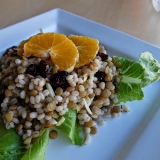
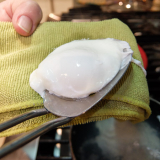
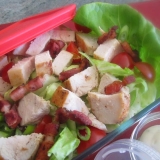

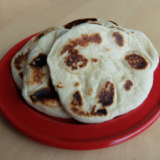

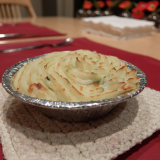
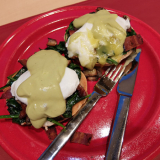

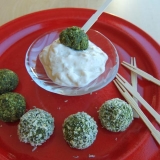

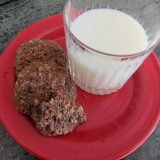
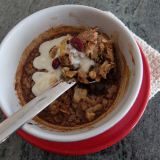
Leave A Comment